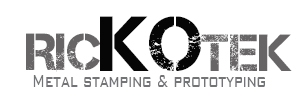The various metal stamping processes produce metal shavings and dust, which combine with lubricants to contaminate the stamped parts.
The contaminants which are Left untreated will negatively impact the performance of the metal part. We must remove the impurities before sending the parts to any secondary processes or operations, including welding or metal finishing, or the assembly/manufacturing line.
While some parts only need one cleaning process, there are cases where the components need more than one cleaning process after stamping.
Typically, metal stamping manufacturers will offer in-house cleaning services.
In some cases, however, they may use the specialized cleaning services of an approved supplier.
Cincinnati-based Cimcool Fluid Technology, a specialty company dealing with metalworking cleaning fluids, reckons that the preparation process before conducting the finishing operation is critical to the metal forming process’s quality.
When performing painting, plating, e-coating, chromatin, as the finishing process, the quality of the finish is dependent on the cleaning process and the compatibility of the cleaning process with the finishing process.
As an illustration of the importance of cleaning, Cimcool points out the typically stringent testing programs in the automotive industry to ensure that the cleaning methods are effective. In such programs, tests are conducted after cleaning and after welding, priming, and even painting.
Cleaning Options Available For Metal Stampings
Degreasing and passivation are two of the most common cleaning processes in the metal stamping industry.
We will cover the cleaning processes that involve the removal of metal shavings from the parts, including deburring and electropolishing in a different article.
- Degreasing: vapor or aqueous degreasing
- Passivation: nitric acid or citric acid
- Immersion or In-line spray cleaning
- Rinsing followed by taking the metal through a rust inhibitor
- Deburring
- Electropolishing
- Sterilization
Vapor & Aqueous Degreasing
How does It Work?
Vapor and aqueous degreasing are the most popularly/ commonly used degreasing processes.
Vapor degreasing involves placing the cold parts in the degreaser for steaming. The solvent vapor condenses on the parts, thereby dissolving the oil and all some of the other contaminants.
To ensure proper cleaning of the parts, they are heated until the temperature is raised enough that condensation on the parts’ surface does not occur and the solvent drains.
Alternatively, parts are immersed in the solvent and rotated or agitated using ultrasonics (for the smaller and/fragile components).
Aqueous degreasing is done by immersing or in-line spraying the parts in/with alkaline or acidic water-based metal cleaners formulating to remove stamping fluids. In some cases, ultrasonics are used to aid the removal of residues.
Advantages
#1. Modern degreasing processes are environmentally friendly. They use less toxic solvents, and the run-off oil is usually distilled and later processed.
#2. Manufacturers can use vapor degreasing on various metals, including galvanized steel, stainless steel, copper, bronze, and aluminum.
#3. Vapor degreasing can be used to clean fragile stamping parts that cannot be tumbled. Additionally, this cleaning is suitable for cleaning complex parts that require more thorough cleaning, such as medical device parts.
#4. Aqueous degreasing is suitable for cleaning stamped parts with water-soluble lubricants.
Passivation
How It Works
Passivation is a process where stamped metal parts re-immersed into citric or nitric acid to remove the free iron and other contaminants introduced during stamping.
After the immersion, the treated parts are rinsed and dried, forming a chromium oxide film that is corrosion and rust-resistant. The treated surface also enhances sterilization. Passivation retains the appearance of the part.
Advantages
#1. Passivation offers high volume parts production and effective means of treating and producing rust-resistant parts.
#2. This cleaning method is suitable for cleaning stainless steel, and in some cases, titanium and other metals.
With all its benefits, it is essential to note that it does not yield a smooth appearance, nor does it provide a high level of corrosion resistance as the more expensive electropolishing.
Additionally, some metals such as copper, carbon steel, aluminum cannot withstand specific acid solutions.
How To Choose The Right Cleaning Method
Selecting the best cleaning method needs an intricate understanding of the type of metal materials you are dealing with, the strength, size, and fragility of the parts, the level of cleanliness you need, and the metal finishing you will apply on the parts.
It is crucial to keep in mind the environmental standards you need to adhere to. When following specific criteria, you must preclude certain solvents.
Metal stamping engineers are the best-placed professionals to guide you on cleaning and finishing your metal parts. They will advise on the most effective options for stamped parts, considering the parts’ compatibility with industry standards and their specifications.

